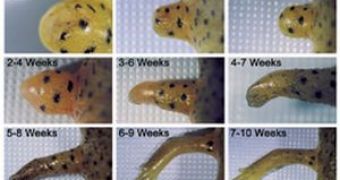Regenerating limbs like the Terminator robot could be in our reach one day as science may be one step closer to understanding this phenomenon.
Scientists at The Forsyth Institute have investigated how a limb or a spinal cord can be regrown, finding that the process implies cellular death. This research may provide clues to understanding the mechanisms necessary for therapeutic regeneration in humans, potentially addressing tissues that are lost, damaged or non- functional as a result of genetic mutations, birth defects, cancer, degenerative diseases, accidents, aging and organ failure.
The research team made its investigation on tadpoles of African clawed frog (Xenopus), an ideal model for studying regeneration because they can re-grow a fully functioning tail and all of its components, including muscle, vasculature, skin, and spinal cord.
The researchers investigated the role of apoptosis (programmed cell death in multi-cellular organisms) in regeneration, a process that proved to be critical in regeneration. "Simply put, some cells have to die for regeneration to happen." said Dr. Michael Levin, Ph.D., Director of the Forsyth Center for Regenerative and Developmental Biology.
"We were surprised to see that some cells need to be removed for regeneration to proceed," said Ai-Sun Tseng, Ph.D. "It is exciting to think that someday this process could be managed to allow medically therapeutic regeneration."
The team investigated the dynamics of cell number control in the regenerating tail bud. Apoptosis had been shown in previous studies to be involved in the sculpting of growing tissue in a number of developmental systems including heart, limb and craniofacial patterning. Despite the massive tissue proliferation required to build the tail, an early apoptotosis is required for regeneration. Normal tail regeneration implies a small center of apoptotic cells; when apoptosis is stopped during the first 24 hours, regeneration cannot proceed and the growth of nerve axons becomes abnormal.
Later inhibition of apoptosis has no effect, thus the programmed death of a specific cellular component is a very early step in the regeneration program. A possible explanation is that tissues normally contain a population of cells whose purpose is to prevent massive growth in the region surrounding them. Future investigation will find the cells that must die, in order to see the signals that cells utilize for growth control.

 14 DAY TRIAL //
14 DAY TRIAL //